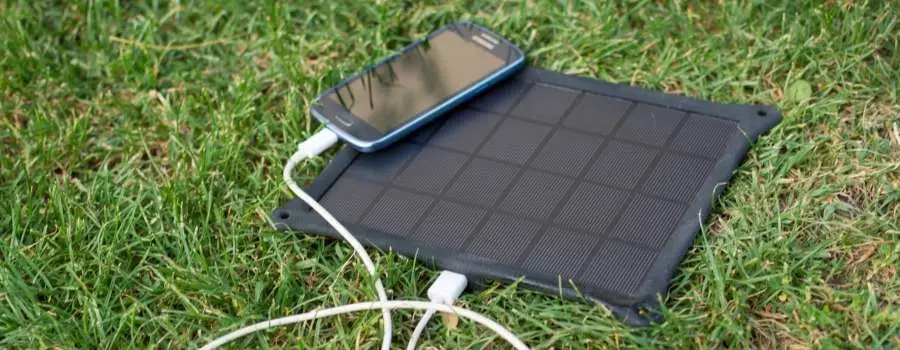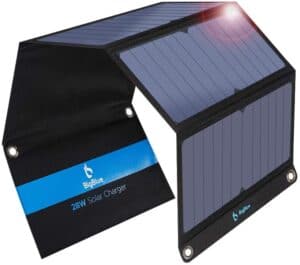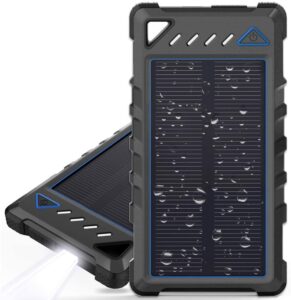
You might not be able to find an electrical outlet on the side of the road, but mother nature does provide us with the best source of clean and renewable energy: The sun.
The technology for harnessing solar power is more advanced than ever before and also more accessible. Commercially available equipment is within the grasp of the average shopper. Now, most people can afford the ultimate piece of emergency survival equipment: A solar-powered portable charger.
The charger you’re buying depends greatly on the item you anticipate needing an emergency power supply for.
What was the first thing you thought of? Probably your smartphone. There are portable solar chargers that can even recharge your car battery. So you have options…and things to look out for…when choosing a portable solar charger that’s right for you.
1. Consider The Drawbacks of Portable Solar Chargers
Make no mistake. A portable solar charger is a handy thing to have and it will provide you with some electricity. But they are far from flawless. Here are a few of the holes you’ll find in them.
Higher Price Point
Portable solar chargers are not like the normal chargers that you can pick up for anywhere from a dollar to $20 at a checkout counter. Plan on spending closer to $75.00 and be careful to take good care of it. Not unless you always have an extra $75.00 just laying around.
Not Always Reliable
Portable solar chargers depend on full sunlight to do their job correctly. If you’re stuck needing emergency solar power on a cloudy day or at night, then you could be at a disadvantage.
Consider too that not all solar chargers are able to store the power they generate long-term. It can literally be a case of use it or lose it.
Specialization
All-purpose portable solar chargers do exist, but there are also portable solar chargers that will only work with a certain type of device, like cell phones or laptop computers.
Be open to the possibility that you’ll be lugging around more than one kind of portable solar charger.
Solar Power Takes Longer To Charge
Even with top-of-the-line equipment, solar power charging is a long process compared to traditional charging through an outlet. It’s not the best option to have in a genuine emergency.
If you’re out hiking with family or friends and you’re way off the grid and someone has a medical emergency, you likely won’t have the time to let your totally dead phone get enough of a charge to call emergency services.
If you’re being circled by grizzly bears while you’re cornered inside your tent, the time required for your phone to get enough power to let you make a phone call may be longer than the patience of the bears.
Low Efficiency
The technology behind portable solar power has come a long way, but it still isn’t able to keep up with the power demands of most of the devices you’d use it for.
In other words, it wouldn’t be a good idea to try and work on your laptop for four hours while using a portable solar charger as the sole power source. Be shrewd about not only what you use a portable solar charger for, but also how long you use it.
Just because a portable solar charger has six different charging ports, it doesn’t mean that you can plan on having a mobile office wherever you go.
For more information about how well solar chargers work, check out: Do Solar Power Chargers Work?
2. Kinds of Portable Solar Chargers
CIGS
There’s room for a joke in here about lighting your CIGS with the sun, but we’re going to pass for now. Anyway, CIGS is an acronym for copper, indium, gallium, and selenide.
CIGS solar chargers aren’t going to give you any extra weight to carry around. They’re your most lightweight option.
They’re made from a flexible, non-rigid fabric, which ups their portability and storage factor. You can easily tuck one of these chargers inside of a bag when not being used. It’s like storing an extra shirt or blanket.
CIGS will also get you some electricity even during overcast and partially shady conditions, at least compared to its companions, the monocrystalline and polycrystalline models. Depending on the model you buy, you might land an efficiency as high as 16%.
Ironically, the upside of CIGS chargers is also one of their downsides. Their thinness makes them portable, but it also makes them less durable and they don’t last as long as the other types.
CIGS may have the advantage in overcast conditions, but when it’s fully sunny out, those other monocrystalline and polycrystalline models are more efficient.
Monocrystalline
They’re heavy, they’re rigid, but they last longer and they make the most out of full sunlight. They may not have the flexibility of CIGS chargers, but they can normally be folded up. The panels usually have a black look to them. A good monocrystalline charger will offer you an efficiency rating of about 22%.
Polycrystalline
These are the panels that have a bit of a blue look to them. They aren’t as efficient as their monocrystalline neighbors and they typically rate at about 18%.
They also don’t handle high temperatures very gracefully. Its silicon purity is much lower compared to other panel modules. High temperatures can drop the efficiency between 14% and 23%.
Polycrystalline also doesn’t stand up to much physical abuse. Not that you’d be using your solar charger in a game of frisbee, but the charger can be damaged from something as basic as a twig or heavy branch falling on them in high winds.
These are also the most space-hogging material.
3. Choosing Your Portable Solar Charger
If you don’t have much experience using solar technology, the options and variables involved in choosing a solar charger can be overwhelming. So let’s try to figure out what your needs are.
Now here’s a question that’s going to sound ridiculous: do you even need a portable solar charger? Hear us out.
If you’re going to making a one-day trip, you can save a lot of hard-earned money and just get a power bank to plug your phone into. A solar charger is a big answer for big problems, and a one-day trip is rarely such a big problem.
On the other hand, if you’re going to be gone on a very long journey where there likely won’t be any electricity to be found, then a portable solar charger is your best option. Or possibly your only option.
So about the criteria for picking out your charger…
Wattage
The wattage of the solar charger will affect what can be charged with it.
The most commonly charged item is a simple smartphone that isn’t quite as power-hungry as the latest-and-greatest models. A 4 or 5-watt charger should take care of you.
But if you have a high-drain device like an iPhone then you’ll need a charger that can manage 7 watts. Do you have an iPad? You’ll need more wattage still: at least 15 watts of output. And if for some reason you need to keep your laptop computer juiced up, then you’ll need a battery and a power inverter to change DC to AC.
Output
What kind of weather will you be experiencing when you plan on using the portable solar charger? Is it likely that you’ll be stuck someplace where it’s cloudy and rainy? If so, you’ll want those brief moments of sunshine to generate as much power as possible.
Be sure to read what’s in print on the product about maximum output power, especially when there may be more than one port on the device which will also affect how much juice the charger can move at once.
Check The Connection Types
These days, many things run on standard USB ports, including portable solar chargers. But there’s always those electronics that need some special adapter if they’re going to take advantage of what’s standard for everyone else. Digital cameras are notorious for this.
Think ahead and makes sure what kind of adapters you may need to charge your devices. Does your device have one of those cigarette charging ports? There’s a good chance you’re going to need an adapter for it.
Integrated Batteries
It would be nice if you could have your portable solar charger soak up some power from the sun so you could tap into some power later on. Integrated batteries will allow you to take advantage of the sunlight that’s available now so you can store energy for when you actually need it later.
We all know that Murphy’s Law will have you in full sunlight while your phone battery is in the green, but then it’ll rain all evening when you need the power. But as with any electronics, the more the features included, the more you’re going to end up paying.
Convenience

Did you think that all portable solar chargers are small and light enough to fit under your arm? Nope. Some of them are quite bulky and unwieldy. Others are designed to fit on, if not in, your backpack while others weren’t made for long hiking trips at all.
A mammoth mobile solar station that stands five feet tall and unfolds ten different ways is going to look very out of place at your family picnic.
There are also some chargers that require some assembly and installation.
Weight
Some hiking trips can last several hours to several days, and not all portable solar chargers have been designed to be carried long distances. Take care in selecting a charger that will agree with your back and your energy levels for the duration of your adventure.
Expense
There really isn’t such a thing as a cheap portable solar charger. There are cheaper ones, but none that are truly cheap. So budget your money for this investment carefully.
The fewer and less complicated your needs for remote energy in a crisis, the less money you’re going to have to pony up.
Sometimes it’s more affordable to buy a solar charger without an integrated battery. It may also be more energy-efficient to use your charger that way, too.
Toughness
Some portable solar chargers are pretty rugged. Others seem to fall apart as soon as you sneeze on them.
The charger you end up buying will be determined by whether the charger is going to stay in one place free from bumps and scrapes and falls, if it’s going to be worn on your back with all kind of other objects where it’s prone to falling, tumbling, and colliding.
And just like the watch you wear on your wrist, some portable solar chargers are waterproof and some aren’t. You don’t want hundreds of dollars to literally get rained out at the first few drops from the sky.
Realistic Applications of a Portable Solar charger
This article is going to divide people into two camps. The people that will think that they can no longer travel anywhere without a portable solar charger and people that are puzzled as to why you want to haul around an extra piece of equipment.
First and foremost, things can happen. The good thing about our increasingly connected world is the fact that when there’s an emergency, help is a call and a GPS coordinate away.
The bad news is that all of this still depends on having some kind of power source.
Cell phones: A portable solar charger could be a literal lifesaver if you’re in the wilderness with a grievous injury or medical condition. As long as you can make contact with the outside world, the rest can happen in short order.
More benign, you might be on a beach where your child is playing and giving you some of the most memorable shots that belong in the family photos. A quick plug-in will give you a chance to make those pictures happen before the chance is gone.
GPS: You’re in the wilderness and whichever device you’ve been using to find your way is low on power. And you didn’t take the time to figure out how to tell which direction is North and you didn’t pack a map of any kind.
You’re definitely going to need some recharge time if you want to see the outside of the forest again.
Laptop: You agreed to submit a report or other piece of data once you reached a certain destination, but you’ve been delayed much longer than expected and your laptop’s battery is waning.
You planned to electronically journal the trip you’re on, but the laptop battery isn’t holding up under all your usage.
A portable solar charger could buy you enough time to get that information into the ether.
Car Battery: How many feelings are worse than getting in your car and turning the key and hearing nothing or just a series of clicks?
It might take a little while, but there are solar chargers that can get enough juice back into your car battery so you can start it up and get out of wherever you’re stuck.
So charging a car battery with a solar charger might take a while…but how well would a solar panel work? I did a little research over here: Can You Charge A Car Battery With A Solar Panel?
Medical Equipment: Lots of rechargeable medical equipment allows people the freedom to get around, provided they will have a way of recharging those devices at some point.
Per the power requirements of such devices, a portable solar charger can buy you precious time when such equipment is unexpectedly drained. But it getting in contact with emergency services as mentioned above would probably be far more practical.
Can You Make Your Own Portable Solar Charger?
If you’re raising your eyebrows at this notion, then you probably never got those science kit catalogs in the mail when you were a kid. Solar power is still a largely DIY industry since no two demands for solar power are the same.
If you spend your money intelligently, you can assemble a charger for as little as $20.
A soldering iron and some basic guidelines will have you boasting about using a charger you made at home in no time.
Of course, you want to make sure the thing actually works before you take it out on a trip. It wouldn’t hurt to check it for durability also. A device that works well until something as benign as a twig falls on it, then it isn’t going to be helping anyone anytime soon.
Maybe building your own solar charger isn’t in the cards…but what about troubleshooting them and repairing them? Check this article out: Why Isn’t My Solar Power Bank Working? What To Look For
Suggested Portable Solar Chargers
1. BigBlue 28W USB solar charger
It features four efficient solar panels that fit inside a convenient bag and they’ll fit nicely into whatever backpack you have.
Better yet, the reviews say that there have been good results using this charger even during cloudy and rainy conditions.
But be warned, this charger isn’t one of the lighter ones. It weighs a good 1.3 lbs, which isn’t much by itself, but could make an already heavy backpack seem heavier. And for all that weight, there’s no external battery bank. If you want that stored-up power for use later, you’ll have to spend the extra money on a battery bank separately.
2. BEARTWO portable solar charger
Here’s a budget-priced portable solar charger that focuses on your cell phone. It’s a very light 7.4 ounces and is the perfect companion for your phone. Its price point is just as low as the first charger we listed. It’s not a delicate charger. It’s water-resistant, dust-resistant, and shockproof.
But no piece of electronics is perfect. This charger is so small and light because it’s just one lone solar panel. It’s not going to deliver a full charge in fast order even if you have it out in direct sunlight.
It’s much more prudent to charge the battery as much as they can at home and use the solar charger to maintain that charge instead of restoring it.
The good news is that this device does have its own internal battery, so you have the option of charging a device without the help of the sun. Hence the wisdom of keeping this device’s charge full as often as possible.
It also has two charge ports. You can use it to charge two devices at once.
Final Thoughts
A portable solar charger can be a lifesaver if you need to charge your phone for an emergency phone call. Depending on the power demands, such a charger can allow you to operate something like a mobile operations center. But don’t be too extravagant with the power you generate off the grid if you don’t think you’ll be back anytime soon.
We don’t see emergencies coming. That’s part of why we call them emergencies.
Your cell phone, GPS, cameras, and other relatively low-drain devices will benefit from having a portable solar charger on hand. And you’ll be generating the cleanest energy possible.
At the end of the day, it’s better to plan for emergencies instead of trusting another piece of equipment to take care of us. It’s always preferable to prevent emergencies if we can see them coming.
Otherwise, there are portable solar chargers for some things that just can’t be anticipated.
We especially ask you to leave for your trip with your devices charged up, instead of relying on a portable solar charger to take care of you along the way. Any power that is used casually may be desperately needed in a true emergency later.


